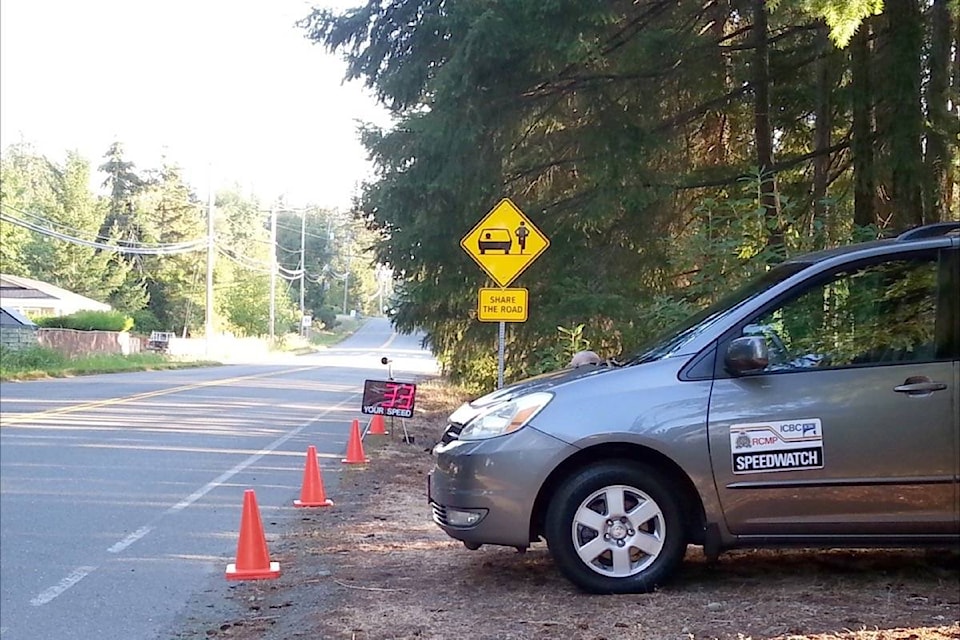It was backpacks on, pens and calculators ready and school zones back to 30 km/h earlier this month, but like a student who forgets their trusty HB pencil, some motorists forgot to slow down.
In their annual effort to remind drivers of the return to slow speeds in school zones, the Oceanside Community Safety Volunteers deployed the week of Sept. 4 with their cones and speed boards in tow.
While stats showed an overall decrease in speeding the longer the volunteers were deployed, there were many who drove well above the speed limit, according to stats from OCSV.
At Arrowview Elementary School, over a period of two mornings, 32 drivers drove more than 40 km/h out of 736 observed.
The highest speed was 60 km/h.
In an afternoon deployment, 41 drivers went more than 40 km/h out of 565 observed, with the highest speed 63 km/h. Four drivers were distracted by cellphones.
Deployments at Oceanside and Nanoose Bay elementary’s saw similar numbers:
- Oceanside: In one morning, 402 observed, 43 drivers over 40 km/h, highest 61 km/h
In one afternoon, 400 observed, 58 drivers over 40 km/h, highest 59
- Nanoose Bay: In three mornings, 1,723 observed, 43 drivers over 40 km/h, highest speed 63 km/h and seven cellphone distractions
In two afternoons, 898 observed, 52 drivers over 40 km/h, highest speed 53 km/h and two cellphone distractions.
That doesn’t quite tell the whole story, though.
RELATED: Parksville-area watchdogs say drivers getting message on cell use
OCSV’s programs administrator, Mike Garland, said, at Nanoose Bay Elementary, top speeds reduced each day volunteers were there.
“The first day, we had somebody going over 60 in the 30 zone. The next day we had somebody going 57 and by the third day, the fastest speed we had was doing 43,” he said.
That shows people get used to the reduced speed, Garland said.
“The experience that I think for most of the locations is pretty consistent, is that once motorists are educated, they do adhere to the speed limit,” he said. Though, he noted that, all three days at Nanoose Bay Elementary, as soon as OCSV members packed up, cars seemed to pick up speed once again.
“As we seem to take down our displays, people forget that it’s a 30 zone.”
But OCSV is speaking with some municipalities suggesting a change that could make it easier for motorists to remember when school zones are in force.
Currently, school zones are only in force for particular periods (generally 8 a.m. to 5 p.m. or 7 a.m. to 4 p.m. depending one when school is in at a particular school), and only on days that there is school.
This can make it difficult for drivers to figure out what the actual speed limit is at a given time, said Garland.
Other places have now made school zones playground zones, “So motorists now automatically know that if they’re going through this area, it’s going to be 30 km/h,” explained Garland.
When it comes to OCSV speed watch deployments, Garland noted that volunteers aren’t there to enforce the speed limit or shame anyone, but to educate people about what the speed limit is and remind them.
As a way to show that there isn’t an adversarial relationship between the volunteers and drivers (and to encourage volunteers), they also make note of the waves, thumbs up and other positive messages they get from motorists while deployed.
Those ranged from dozens to a couple hundred at these school deployments.
Garland said OCSV looks to continue deployments around local schools (including ones not listed here), focusing on through-roads and provided there is a safe place for OCSV members to set up.
